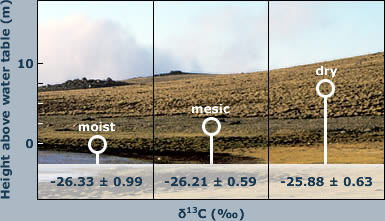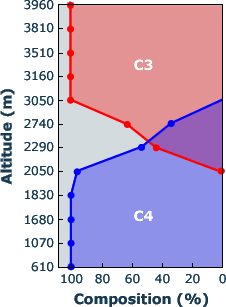 |
|
|
|
|
|
|
1 - No difference in carbon isotope discrimination (δ13C) in herbaceous plants across a moisture gradient from the shore line to semi-desert slopes, suggesting that moisture is equally available to plants ("Laguna Nostra", Cumbres Calchaquies Mts. of NW-Argentina, 4250 m, March 1987). |
Theory:
|
|
2 - The percentage of C4 grass species declines dramatically along an altitudinal transect on Mt. Kenya. (Tieszen et al. 1979; see Körner 2003) |
A second fingerprint of drought is the abundance of the C4 syndrome, a very efficient mode of photosynthesis adopted by many plants originating in dry areas (e.g. desert vegetation; but also corn, Zea mays). Most other plants perform the C3 mode of photosynthesis (C3 plants). In contrast to C3 plants, C4 plants hardly discriminate against 13C, hence can easily be distinguished from C3 plants. Clearly C4 plants become very rare with increasing elevation. Above treeline they do not normally contribute significantly to plant biomass even in semiarid mountains. Fig. 2 illustrates the transition from C4 to C3 plants along the slope of Mt Kenya in Africa. The climatic treeline is at ca. 3800 m. |
|
For further information on the C4 syndrome consult textbooks or Botany Online - The Internet Hypertextbook. |
29 August 2011 |
||
| |
||

